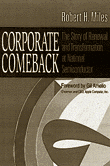"Corporate Comeback: The Story of Renewal and Transformation at National Semiconductor" by Robert H. Miles
Corporate Comeback: The Story of Renewal and Transformation at National Semiconductor by Robert H. Miles (371 pages, Jossey-Bass Publishers, 1997)
(originally published by Booz & Company) The National Semiconductor Corporation represents both the glory and the vainglory of American industry.
The National Semiconductor Corporation represents both the glory and the vainglory of American industry.
It had the kind of early history typically portrayed in old movies as a train in motion: cut from a long shot of a locomotive to a close-up of the wheels as they gather momentum; the sound of the pistons pulsates ever faster and more rhythmically until the train flies, unstoppable, across a prairie that stands in for the future. When National was founded in 1959 to bring the new semiconductor technology to two infant industries with seemingly endless promise — computers and communications — its own horizons looked open and endless as well.
But as Robert H. Miles tells it in Corporate Comeback: The Story of Renewal and Transformation at National Semiconductor, by the 1980's the company's high-volume, low-price strategy fell prey to overcapacity, trade restrictions and global competition. That the world might catch up with this prodigious manufacturer never seemed to enter anyone's mind until it was well into its decline. By the time the company called in the white hats — one of whom was Mr. Miles — it was down to the dregs of its cash reserves and, in the current favorite phrase of the consultants, in a "death spiral."
Corporate Comeback is an account of National's reversal of that spiral and its return to health, led by Gilbert F. Amelio, who, even as you read this, is trying to work the same magic at Apple Computer. Corporate Comeback may not, as the penny-dreadful jacket copy reads, be a "riveting day-to-day" tale, but it is more than usually interesting and is, in many ways, the very model of a management book.
The central problem of the corporate transformation, contends Mr. Miles, who was a consultant to Mr. Amelio during the makeover, is "how to achieve fundamental change without exposing the organization to unacceptable risk." Of course, it is hard to define "unacceptable risk" for a company that has managed to drift its way to the brink of oblivion. When Mr. Amelio stepped in, says Mr. Miles, "National was below the industry average by virtually every benchmark metric," from return on equity to revenue per employee to operating capacity. And while there were internal company weaknesses, externally the entire semiconductor market was changing.
From the first day, Mr. Amelio called for a total remake, from top to bottom, and, with the help of a legion of consultants, helped plot out a program of intentional change. The company adopted what Mr. Miles calls a "total system approach," mapping out seven areas — vision, strategies, infrastructure, culture, competencies, people and structure — that would come under analysis. In the strategy category, for example, Mr. Amelio was determined to move from a manufacturing-driven orientation to one driven by the market. The systems approach looks at how change in one area reverberates in another. Moving toward the market would mean National would have to abandon its traditional product-line organization, and institute a structure organized around customer groups.
Most of the changes Mr. Amelio and his lieutenants envisioned challenged the basic assumptions of the company and its employees. Much of the breaking down and replacing of those assumptions was accomplished by seminar, a method many employees regard as a kind of death-by-chatter. At least in this account, National's seminars, which were customized for each employee level, appear to have accomplished their purpose, if only because the company's commitment to them drove home the seriousness of its situation.
In fact, the only serious public resistance discussed in the book arose among the very people — middle management — who tend to resist change and was resolved civilly between two levels of management. Asked to list obstacles to transformation, middle management apparently went out on a limb and cited, among other things, senior management's "lack of trust and credibility." The senior managers' response is an indication that the seminars truly did resemble Quaker meetings more than episodes of Doom: they first pledged not to wreak revenge on the people who spoke out.
According to Mr. Miles, it took National two years to move from being a "troubled company to a viable one." It almost surely did not go as smoothly as Mr. Miles recounts it in "Corporate Comeback." Like preachers who don't let their knowledge that people can fall from grace intrude on their faith, consultants with the vision thing like — and probably need — to keep their eyes trained on ideals and the arc of progress rather than on the petty gore of day-by-day change.
National found itself Mr. Amelio, a visionary who could inspire others to "walk the talk" of transformation, and Mr. Amelio brought in consultants like Mr. Miles, who could help teach the troops how to walk the talk. O.K., maybe the story of how they did that is a tiny bit riveting. In any case, it's well worth the read. ![]()


